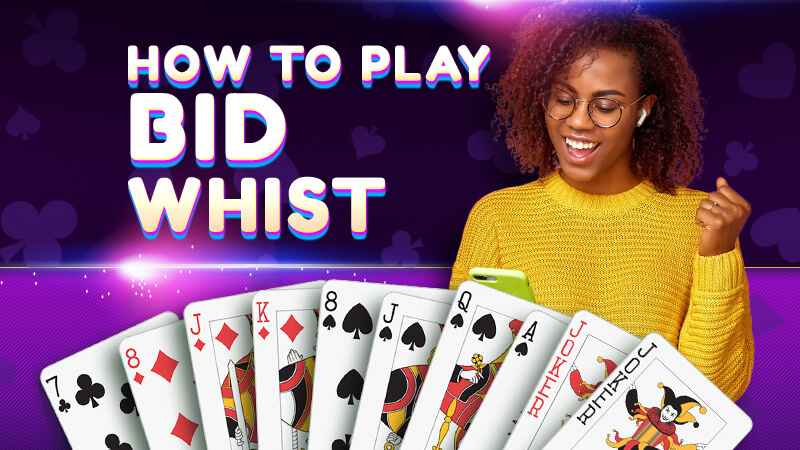Players must employ cunning bidding tactics and skillful card play to outwit their opponents and secure victory. In this article, we will delve into the cultural significance and rules of Bid Whist, inviting you to explore this captivating card game.
1. Understanding the Basics
You have three main components to familiarize yourself with, mainly:
The standard deck
Bid Whist is played with a standard deck of 52 cards, plus the two jokers. The deck consists of four suits: spades, hearts, diamonds, and clubs. Each suit contains thirteen cards, including ace, king, queen, jack, 10, 9, 8, 7, 6, 5, 4, 3, and 2.
The number of players
Bid Whist is typically played by four players, forming two teams of two players each. Team members sit opposite each other at the table, ensuring that partners are not seated next to each other.
The card rankings
The ranking of the cards within the suits varies based on the bid.
- Uptown trumps: Big joker, little joker, A, K, Q, J, 10, 9, 8, 7, 6, 5, 4, 3, 2.
- Uptown non-trump suits: A, K, Q, J, 10, 9, 8, 7, 6, 5, 4, 3, 2.
- Downtown trumps: Big joker, little joker, A, 2, 3, 4, 5, 6, 7, 8, 9, 10, J, Q, K.
- Downtown non-trump suits: A, 2, 3, 4, 5, 6, 7, 8, 9, 10, J, Q, K.
If the bid is no trump, all the suits become non-trump suits. In this situation, the jokers hold no value and cannot secure a trick. But, they can be played if you don’t have a card of the suit led.
In the rare scenario where a player leads with a joker, the next player can play any card. The suit of the first non-joker card played then establishes the suit that must be followed for that trick. The highest card played within this suit wins the trick.
2. How to Play Bid Whist Card Game
To play Bid Whist effectively, it’s crucial to understand the following steps and concepts:
- Determine the dealer by drawing cards. The player who draws the first diamond becomes the dealer.
- Deal the cards. Each player receives 12 cards. Six cards are placed face down in the center of the table to form the kitty. The kitty can be created at any time during the deal, but the first or last four cards cannot be included in the kitty.
Bid a number of tricks from three to seven. The bid represents the number of tricks above six that your team aims to win. For example, a bid of five implies a commitment to win 11 tricks. The highest possible bid is seven. “Uptown” indicates that high cards will prevail. “Downtown” suggests that low cards will have an advantage. “No trump” means that if your team wins the bid, you can determine whether high or low cards take precedence. - Choose to pass or make a higher bid. Players can either pass, indicating they don’t wish to bid higher or make a bid higher than the previous bid.
- Lead with any card. The player who won the bid leads with any card of their choice. Subsequent players must follow suit, playing cards of the same suit if they have any. Non-leading players can play a trump card or a card of a different suit. Trump cards beat non-trump cards. The highest-ranking trump card or card of the led suit wins the trick, and the player who wins leads the next round. If a player fails to follow the suit led when they have cards of that suit, it is known as a renege. Tricks won by the team that reneged must be given to the opposing team.
- End the game. The game concludes when a team achieves a cumulative score of plus or minus seven. Alternatively, if a team reaches a cumulative score of minus seven or worse, the game ends.
3. Scoring
Understanding the scoring system in Bid Whist is essential to track progress and determine the winner:
- Each team starts with a score of zero.
- The bidding team either wins or loses points at the end of each hand.
- The game ends when a team achieves a cumulative score of seven or more or reaches a cumulative score of minus seven or worse, resulting in a loss.
- At the end of the play, the tricks are counted (13 in total).
- Each trick won above six counts as 1 point.
- The bidding team must make at least as many points as they bid in order to score.
- If the bidding team meets or exceeds their bid, they score all the points they made.
- If the bidding team fails to take enough tricks for their bid, they are ‘set’ and score nothing for their tricks.
- In case of being ‘set’, the points they bid are subtracted from their score.
- The opponents of the bidding team do not gain or lose any points.
4. Tips and Strategies
To enhance your gameplay in Bid Whist, consider the following tips and strategies:
- Understanding your opponents’ patterns. When playing Bid Whist pay attention to the cards your opponents play and their bidding patterns. This can help you anticipate their strategies. Observing their card choices can provide insights into their hand’s strengths and potential weaknesses.
- Remembering cards played. Try to remember which high-ranking cards have been played, allowing you to make informed decisions about when to play your own high cards or trump cards. Memory and awareness of the current card distribution can give you a competitive edge.
- Effective bidding strategies. Assess the strength of your hand before bidding. Consider factors such as the number of high-ranking cards, the presence of a strong suit, and the potential for winning tricks. Additionally, take your partner’s bid into account. Collaborate with your partner to estimate the combined strength of both hands and strategize accordingly.
5. Bid Whist & Spades
As you might have figured out, Bid Whist and Spades are similar card games, mainly because Bid Whist is the initial prototype of many classic card games, one of which is Spades. Here’s a rough comparison highlighting the main differences between Bid Whist and Spades:
| Rule | Bid Whist | Spades |
|---|---|---|
| Players | 4 | 2, 3, or 4 |
| Cards | 52 + 2 Jokers | 52 (regular game) |
| Trump suit | Determined by bidding | Spades |
| Bidding | Must be higher than the previous bid | Any number from 0 to 13 |
| Partnership | Players form teams | Players either form teams or each plays individually |
| Scoring | Points based on fulfilling bids | Points are based on the number of tricks won |
| Bag Penalty | No | Exceeding the bid results in penalties |
So, shuffle the cards, engage in lively bidding, and savor the thrill of winning tricks. Bid Whist awaits, promising hours of entertainment and bonding. Let the journey begin!
Now read this fun list of 3-Player Card Games.


